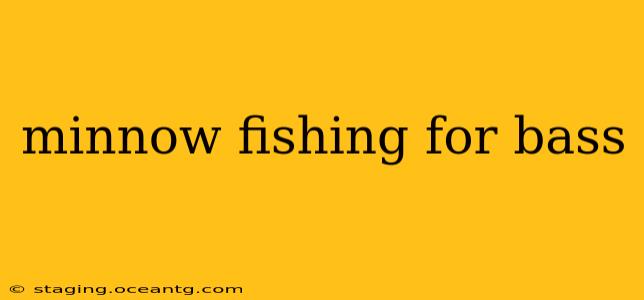Bass fishing is a popular pastime for anglers of all skill levels, and one highly effective method is using minnows as bait. This technique, while seemingly simple, requires understanding the nuances of minnow selection, presentation, and the ideal fishing conditions. This comprehensive guide will delve into the art of minnow fishing for bass, covering everything from choosing the right minnow to mastering effective rigging techniques.
What Kind of Minnows are Best for Bass Fishing?
The type of minnow you choose significantly impacts your success. Larger bass tend to prefer larger minnows, while smaller bass might target smaller baitfish. Some popular choices include:
- Shiner Minnows: Known for their durability and strong swimming action, shiners are a reliable choice. Their silvery sides mimic the flash of many baitfish, attracting bass.
- Golden Shiners: These are another excellent option, offering a slightly different color profile that can be effective in various water conditions.
- Creek Chubs: These smaller minnows are ideal for targeting smaller bass or when bass are feeding on smaller prey.
The ideal size will vary depending on the size of the bass you’re targeting and the overall size of the baitfish in the lake or river.
What is the Best Rig for Minnow Fishing for Bass?
The most common and effective rigs for minnow fishing include:
- Slip Bobber Rig: This versatile rig allows you to control the depth of your bait, crucial for targeting bass at different depths. The bobber slides up and down the line, allowing the minnow to swim naturally.
- Float Fishing Rig: Similar to the slip bobber rig but often uses a fixed bobber, ideal for fishing in shallower water or when you need a more precise depth control.
- Carolina Rig: While not strictly a minnow-only rig, the Carolina rig's weight and long leader allow you to effectively present a minnow in deeper water or through vegetation.
Choosing the right rig depends heavily on the fishing conditions and the structure you're targeting.
How to Rig a Minnow for Bass Fishing?
Proper rigging is essential for keeping the minnow alive and active, thus enticing bass. Here’s a simple step-by-step guide for rigging a minnow on a hook:
- Select the appropriate hook: Use a hook size that’s slightly larger than the minnow’s mouth, allowing for a secure hold without impeding its movement.
- Hook the minnow: Insert the hook through the lips or just behind the top fin, ensuring the hook point is securely embedded. Avoid over-hooking, which can kill the minnow quickly.
- Attach the line: If using a bobber rig, attach the line to the bobber and adjust the depth accordingly. For a Carolina rig, attach the weight and swivel.
Remember, a live, active minnow is far more attractive to bass than a dead or struggling one.
What is the Best Time of Day to Minnow Fish for Bass?
Bass feeding activity often peaks during dawn and dusk, when light levels are lower and they are more active. These periods, often referred to as the “low-light hours,” are ideal for targeting bass with minnows. However, bass can be caught throughout the day, especially during cloudy conditions or when they’re actively feeding.
What are Some Tips for Successful Minnow Fishing for Bass?
- Observe the water: Pay close attention to water clarity, current, and any visible signs of bass activity.
- Match the hatch: If possible, try to match the size and type of minnow to the natural baitfish in the area.
- Patience is key: Bass fishing requires patience. Don't be discouraged if you don’t immediately catch a fish. Continue to adjust your technique and presentation.
- Use light line: Lighter line is less visible to the bass and allows for a more natural presentation of the minnow.
- Keep your minnows alive: Use an aerated minnow bucket to keep your bait lively and active throughout your fishing trip.
Where is the Best Place to Minnow Fish for Bass?
Bass can be found in a variety of habitats, including:
- Near cover: Look for areas with submerged vegetation, fallen trees, docks, or other structures that provide cover for bass.
- Along drop-offs: The edge of a drop-off or a change in depth can be a productive fishing spot.
- Around points: Points of land extending into the water are often hotspots for bass.
Remember, location is key! Spending time scouting and identifying potential bass habitats will significantly improve your chances of success.
By utilizing these techniques, tips, and understanding the nuances of minnow fishing, you can significantly increase your chances of landing that trophy bass. Remember to practice responsible angling and respect the environment. Tight lines!
